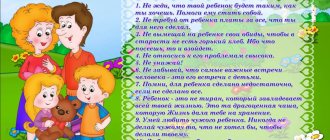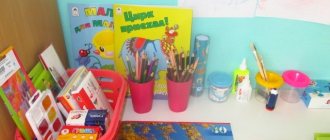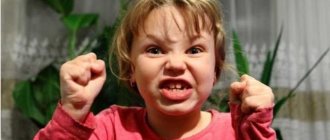Master class on making a stand “Our Creativity”
Evgenia Nemtseva
Master class on making a stand “Our Creativity”
Master class on making a stand “Our Creativity”
Purpose: Decoration of the reception area.
Goal: to decorate the reception area beautifully.
Objectives: To arouse interest in creating a beautiful corner.
Develop aesthetic taste.
2. Colored paper, colored cardboard.
8. Brush, glue bottle.
Progress:
1. Cut out two blanks in the shape of pencils from thick cardboard. I used cardboard that is used for re-arranging furniture.
2. Then we paste over the blank pencils with colored paper. I have green and orange.
3. Cut out elements to create an image from colored paper - eyes, eyebrows, noses, lips, stripes. This is how I got a boy pencil and a girl pencil.
4. Then cover the surface of the pencils with tape. Add pens, scissors, glue, palette and brush.
5. Let's proceed to the final stage. Using a glue gun, glue satin ribbons of the same length to the back side.
6. We print the letters on a color printer for the inscription “ Our creativity ”
. Glue the letters onto the colored circles. We attach the inscription to the top tape.
The stand is ready . Now, using stationery clips, we place children’s works on satin ribbons.
Photo report “Our creativity!” The joint creativity of teachers, parents and children plays a large role in the educational process. To organize the child's free time. Photo report “Our summer creativity” (part 1) This year the summer was not very good, there were many rainy days, but this did not stop us from creating both in the group and on the street. I want to introduce. Photo report “Our summer creativity” (part 2) I bring to your attention the second part of our summer work. As I already wrote, due to the fact that only up to 20 can be placed in a publication. Master class with children of the middle group “Oral folk art” BDOU Kindergarten “Solnyshko”. Onokhoy village. Master class with children in the middle group “Oral folk art”. Quiz “Travel. Photo report “Our autumn creativity” Today there was a real commotion in our group. Everyone worked hard and tried to create a masterpiece. We sculpted and painted, glued and created beauty. Our creativity on the theme “Autumn” Varvara Shchedrova’s family. Family of Timofey Zaitsev. A fabulous autumn has come to visit us! Autumn is a wonderful and beautiful time of year. In many. Photo report “Our creativity” Hello, dear colleagues! You all probably know the feeling when you are happy for your students? When you want to create.
Source
What is the stand for? This device is designed to display important information in a way that is interesting and accessible.
Stands are placed in shopping centers, educational and other institutions. Currently, many companies are engaged in the manufacture of custom-made stands, but you can make it yourself, choosing the most suitable material and size, and also save a lot.
Memo for parents “Home creativity corner” article
REMINDER FOR PARENTS
"Home corner of creativity"
From birth, children are open to the world and very inquisitive; they are ready to share their impressions and experiences with adults. Growing up, this is especially evident in drawing, since not all children can express in words what they feel, and drawing gives them this unique opportunity. Children can draw their own special world, unique and therefore especially valuable, containing a lot of important and unique information.
But, still, there are children who do not like to draw. The need to draw is genetically embedded in us; it is logical to believe that every child should feel the need to draw. But not all children spend their time drawing. The fact is that many children don’t draw not because they don’t want to, but because they don’t know how. Perhaps they would like to draw a butterfly or a flower, but after trying once, they are disappointed that they did not draw it the way they imagined. Do not forget that artistic activity, in addition to its applied function, also has a therapeutic – healing function! There are many techniques based on drawing. The task of parents and teachers is to help the child get acquainted with the world of art in general and drawing in particular.
1. It is necessary to create a corner of creativity. A favorable and safe environment solves half the battle, which means it is necessary to create conditions for the child to be creative! The child should have his own table, a comfortable chair, a lighted and suitable place for drawing, “his own Corner.”
The “Children’s Art Corner” must meet the following conditions:
a) the child must have his own table and chair, and the furniture must be selected according to the child’s height, his feet must be on the floor and form an angle of 90 degrees. Please note that the table should not be cluttered, it should always be prepared for the fact that the child may have a sudden desire to draw;
b) pay attention to the lighting of the table, the lamp should not be very bright or, on the contrary, dim, the light should fall from the left side; It’s good if the table is near the window;
c) due attention should be paid to visual materials: the more colorful and brighter they are, the better, because the child is more likely to reach for a bright felt-tip pen than a faded pencil of poor quality.
Materials must be of high quality and appropriate for the child’s age, and must also comply with safety rules.
Parents should know that the younger the child is, the larger the surface of the sheet should be. With children 3-4 years old, it is better to draw with special thick felt-tip pens (markers should not be given to a child, they can be toxic), large brushes (it is better to put paint from jars on a palette to make it easier for the child to pick it up), pencils are not very welcome. In many ways, children’s reluctance to draw is associated with their first experience of drawing with pencils, since they leave a faded, inexpressive mark, and even require effort. More bright colors, gouache, fingerprints.
For older children, materials such as pastels, wax pencils, and gel pens can be introduced. It is important to remember that materials should always be ready for drawing, pencils should be sharpened, markers should be fresh, and paints should be clean. And remember that it is not necessary to draw on a white sheet, take colored sheets, the background is extremely important. You can also draw on old wallpaper, so you can make every child’s dream come true! And don’t be afraid to draw everywhere - on the street with crayons on the asphalt, in the snow. The main thing is to create.
Art teacher: S. I. Myasnyankina
How to choose material for making a stand?
The most popular material for making information boards is cork. This material has a lot of positive characteristics and is suitable for use in institutions of any type. It is cork that is chosen for stands for kindergartens, as it is a safe and hypoallergenic material. Let us also note other advantages of cork boards:
To decorate the back side of the stand, you can use a thin sheet of plywood or fiberboard.
How to make an information stand with your own hands?
It is absolutely not necessary to have special knowledge and skills to build a stand yourself and add it to a room, a group in a kindergarten or a school class. In order for the product to fit harmoniously into the interior of the room, you need to carefully consider its design. You can experiment with both the main shade and the design of your stand. As the main finishing material, you can use paint, fabric, self-adhesive film and much more.
To frame the stand, you can use a frame made of wood, plastic, aluminum, foam, cable ducts that are suitable in width, and so on.
During manufacturing, it is also necessary to take into account the method of fastening. For more convenient use, a hanging mounting method is recommended, since installation with glue can cause a lot of inconvenience in the future.
Creativity corner for children of senior preschool age article (senior group)
GBDOU kindergarten No. 7
Krasnoselsky district of St. Petersburg
Senior teacher
Tushevskaya Olga Valentinovna
"Creativity Corner"
The subject-development environment is organized so that every child has the opportunity to freely do what they love. Placing equipment by sectors (development centers) allows children to unite in subgroups based on common interests. A rich subject-developmental and educational environment becomes the basis for organizing an exciting, meaningful life and all-round development of each child. The developing subject environment is the main means of shaping the child’s personality and is the source of his knowledge and social experience.
When creating a “creativity corner” the following tasks are solved:
- Create an atmosphere of emotional comfort
- Create conditions for creative self-expression
- Create conditions for the manifestation of children’s cognitive activity
- Create favorable conditions for perception and contemplation, draw children’s attention to the beauty of nature, painting, arts and crafts, book illustrations, music
A “creativity corner” in the senior group can be created under the motto “Feel – Cognize – Create.” It presents:
Materials for artistic and aesthetic activities, their variety:
- Paints (watercolor, gouache), plasticine, pencils, wax crayons, colored paper of various formats and textures, cardboard, brushes (squirrel or kolinsky) thin, medium and thick; rags for hands and hands, paint palettes, aprons, sippy cups for water, modeling materials.
- Easel
- Literature on art, postcards and albums for viewing. Reproductions, paintings, portraits of artists, small sculptures, works of decorative and applied art (haze, Gzhel, Khokhloma and others).
- Various didactic games for familiarization with: genres - still life, portrait, landscape; with painting, graphics, decorative and applied arts, architecture; with flowers and their shades.
- Natural and waste material
- Musical instruments, toys, technical equipment
- Games and attributes for theatrical performance. These are not only materials characteristic of the theater (screens, dolls, costumes, and so on), but also some materials for familiarization with the environment, fiction. There are also “theatres” and characters made by the children themselves during art classes. Theatricalization includes: table theater, sets of dolls, costumes, books, materials for decorations.
Materials for educational activities
- Nature calendars, collections
- Sensory Education Materials
- Visual material, games, aids to familiarize yourself with the world around you
- Fiction and encyclopedic literature
- Didactic and educational games
- Educational games, technical devices and toys, models, items for experimental research work - magnets, magnifying glasses, springs, scales, beakers, etc.; a large selection of natural materials for studying, experimenting, and making collections
- Table for experimenting with water and sand
The “Creativity Corner” is located in a well-lit and accessible place, where students in their free time draw, sculpt, do appliqué work, explore, and transform themselves into fairy tale heroes. It is a place for children's self-development. The group in the “Creativity Corner” combines various types of activities: drawing, modeling, familiarization with musical instruments, theatrical performances, research and experimental activities, work with natural materials, and familiarization with literature.
The “Creativity Corner” is always an actively working area that helps preschoolers develop an interest in making their own crafts, inventing fairy tales and stories, and studying science.
The creativity corner in kindergarten allows you to create optimal conditions in the group for the development of visual activity, independence and creative activity of children. Children get the opportunity to express themselves in various types of artistic and design activities, get acquainted with the world around them, and learn the properties of objects.
Do-it-yourself stand: features and manufacturing principles
So, the first thing you need to start with is the basis of the design. Once the size of the stand is determined, you need to select a cork board and plywood of the appropriate size and glue them together using glue or liquid nails. Next, the workpiece must be painted, covered with fabric or film, and you can begin to decorate it.
You need to start designing the design with the pockets in which sheets of information will be placed. For this purpose, you can use plexiglass of a suitable size or durable stationery files. The number of pockets can be absolutely any.
Next, you need to determine the theme of the design. This could be a lesson schedule, a corner of a healthy lifestyle, congratulations on the holiday, and so on. The name of the stand is an important part of its design. The title should be bright, large and eye-catching. Remember that an information stand is a business card of an organization, so special attention should be paid to its design. Letters for the title can be cut out from bright plastic or from unnecessary magazines.
Remember about the frame of the stand. With a frame, the design will look more aesthetically pleasing and laconic.
Sheets with information and other important information can be attached to the stand using buttons or safety pins, but if we are talking about a child care facility, then it is worth finding an alternative method.
Advantages of making your own stand
Making the structure will not take much time and will not take much effort. In just 30 minutes you can make a simple, small-sized design. With stands of larger size and complexity you will have to tinker a little, but rest assured that the result will exceed all your expectations.
The stands are actively used by people, both at home and in educational, medical, transport and other institutions.
Important information, plans for the future, memorable photographs, an organizer, a list of employees, a class schedule, and this is not an exhaustive list of information that can be located on the stand.
Source
DIY making
To create a stand board at home, you do not need any special skills or tools. It is enough to be responsible and attentive to the work. There are several most common options for “home” stands.
From ceiling slabs
Inexpensive ceiling tiles are perfect for creating custom designs. The simplest option is to attach them to the wall using special glue or self-tapping screws with decorative plugs.
The necessary information is recorded using stationery pins with colored caps. A volumetric frame can be made from strips. They can be cut with a stationery knife from the remains of the panels.
From cork backing
Cork boards have become widespread when creating information boards at home. This is due to the high aesthetic characteristics, strength, ease of processing and durability of the material.
In addition, the cork substrate does not emit toxic substances and does not cause allergic reactions in humans and pets.
To make an information or decorative board, you will need a cork backing for laminate or parquet with a thickness of 1 to 4 mm. All work includes several stages:
- Create working drawings and procure the necessary components.
- Select the material for making the base. It can be plywood, fiberboard, chipboard or PVC sheet.
- Using a hacksaw, cut out pieces of the required size.
- Glue the cork veneer onto the base and carefully trim the protruding edges with a stationery knife.
- The finished board is varnished or a special mastic is applied.
- Select a profile for the frame and secure it to the board. An attractive appearance of the finished product will be provided by frames made of wooden baguette, metal or plastic profiles. It is recommended to use a frame whose width is slightly greater than the thickness of the board.
- On the finished surface, according to the working drawings, pockets for sheets of information are placed. To make them, you can use plexiglass or transparent plastic.
- Select the type of fastening. The panel can be permanently attached to the wall with self-tapping screws or provided with hinged mounting using hinges.
The advantages of a cork front panel include durability, attractive appearance and ease of maintenance.
From a gymnastics mat
For the front side, instead of balsa wood, you can use a gymnastics mat. This accessory is sold in any sports store at an affordable price.
The main advantage of this solution is the variety of color options. In the online store you can choose a color that fully matches the theme of the future design.
The material is easily processed and attached to the plywood base with glue. Otherwise, the manufacturing technology is no different from working with a cork substrate.
Made from PVC sheet
A special feature of such products is that the PVC sheet can serve as both the base and the front side. A large selection of colors and ease of processing make this material one of the most popular in the manufacture of stand panels. For work you may need:
- PVC sheet 3 mm thick;
- stationery files or corners for photo albums;
- PVC profile for making edging.
The work is carried out in the following sequence:
- After developing a sketch, a blank of the required shape is cut out of a PVC sheet. This can be done with a jigsaw or hacksaw.
- Letters for the name of the stand are cut out from the remains of the PVC panel using a jigsaw. They are glued to the front side of the board with special glue.
- Mark the locations of the pockets. Stationery files or pre-made pockets are glued according to the markings.
- Frames are made from a PVC profile or other available material and attached to the front side of the stand. After this, the notice board can be attached to the wall using self-tapping screws or hanging hinges.
If necessary, the front side can be painted with acrylic paint. For greater durability, it is recommended to use façade paint.
Master class on designing the “Our Creativity” stand
The master class is intended for preschool teachers. Children are also very actively involved in the stand design process. They are very fascinated by watching how their toys, pencils, long-abandoned construction parts, which they considered no longer needed and broken, take on a new life.
To make it you will need:
5. And give free rein to your imagination.
This unusual stand adorns our group.
Scenario of the matinee in the senior group “March 8 – Mother’s Day”
Scenario of the matinee in the senior group “March 8 – Mother’s Day” The boys come out into the hall to the music and stand in a semicircle. 1st boy: Here.
Master class on making a stand “Our Creativity” in a kindergarten group
Olga Azimova
Master class on making a stand “Our Creativity” in a kindergarten group
Master class on making a stand “Our Creativity” in a kindergarten group.
“Stand “Our Creativity”.
Purpose:
placement of children's creative works.
Age category:
a kindergarten teacher.
Materials and equipment:
pink self-adhesive
white paper,
pictures for decoration.
The course of the master class.
1. Take a sandwich panel.
2. Using a knife, cut out the workpiece of the desired shape.
3. Take a pink self-adhesive sticker.
4. Carefully glue the self-adhesive onto the sandwich panel blank.
5. Bubbles may form when gluing the self-adhesive.
They can be removed by piercing the bubble with a needle and smoothing the surface.
6. Using a figured hole punch, make flowers from white paper.
7. Glue the flowers along the edge of the workpiece in two rows.
8. We secure the flowers to the workpiece with tape.
10. One part of the stand is ready. There should be two such parts.
11. Take metal profiles.
12. Cover the metal profiles with pink self-adhesive tape.
Children's creative works can now be secured with magnets.
In the fall, the stand can be decorated like this.
This is how you can decorate your stand in winter.
The design can be permanent like this.
Thank you for your attention.
I wish you creative discoveries and success in your work!
“This is what it is, our summer!” Report on preparing the kindergarten site for the summer health season This is what it is, our summer! There is exactly one week left until the long-awaited, beloved summer. Everyone has already started preparing for summer long ago. Master class “Day of the National Flag of Russia in the middle group” of the kindergarten Patriotic education of the younger generation in the field of education in Russia occupies a priority place. It starts from the very first. Master class for kindergarten teachers on making poppies from crepe paper Making “Poppies” decor Nomination: Kindergarten, master class for preschool teachers to unlock creative potential. Creped and. Master class on making an album “Our Winter Fun” in the junior group of a kindergarten Teacher: T. A. Nazarova In our kindergarten there was an event “Presentation of albums about winter sports.” Parents are happy to do so.
Use of stands in kindergartens
The main purpose of this furniture design is to organize a place for children's creative work. Whatever students do - origami techniques, papier-mâché techniques, modeling from plasticine, cross-stitching, sewing, assembling construction sets - each of these will require an original stand. It can be used for specialized exhibitions and for posting new works on a daily basis.
Just imagine how stylish and original children’s drawings and crafts will be decorated if you don’t just put them on a shelf or window sill, but place them on a specially designed stand. The bright design and versatility of the products offered allow us to solve a wide range of problems and satisfy any aesthetic preferences.
In order for stands to be used for displaying work to be selected correctly, it is necessary to ensure that they meet several requirements:
- optimal height (it should be suitable for the children’s height, so that they themselves have the opportunity to erect their next masterpiece, proud of the work done);
- absolute safety (it is desirable that the structures have rounded corners and are made of harmless materials);
- suitable size (it depends on the number of amateur lessons and the number of students in the preschool group);
- designer design (boring monochromatic products are not suitable for preschool educational institutions; it is better to give preference to something brighter, more colorful, catchy and original).
By following these rules, the kindergarten will turn into a real exhibition and will look truly beautiful.







